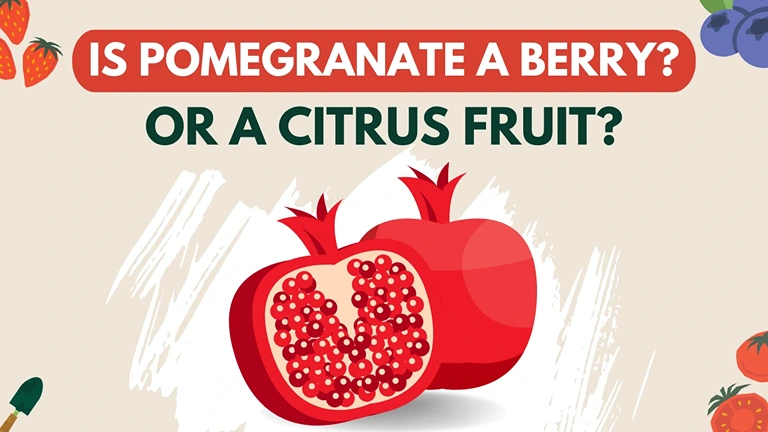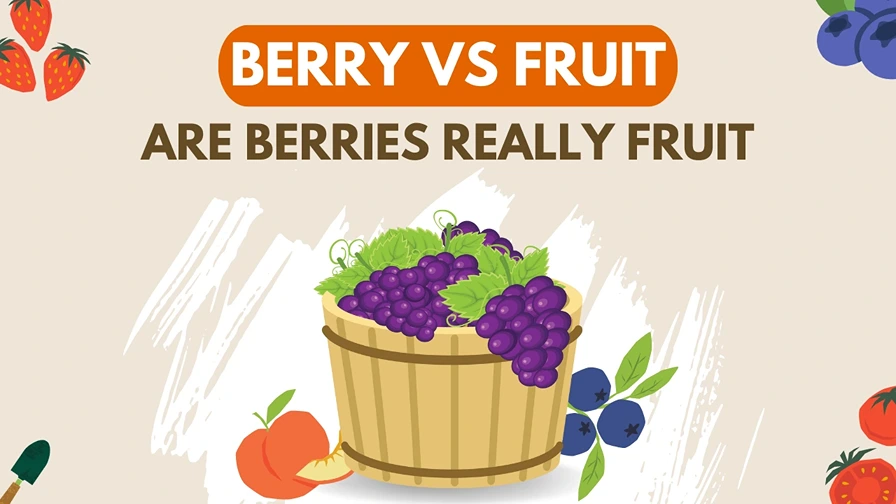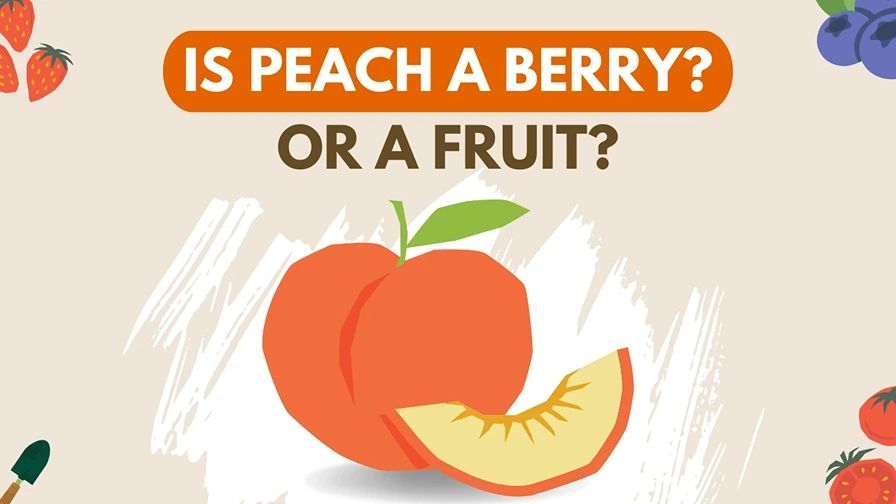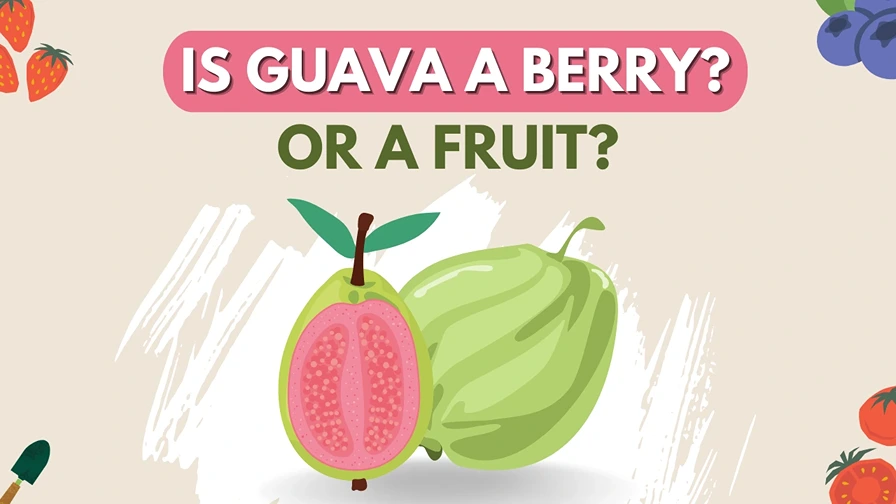Pomegranate is a fruit that is widely known for its delicious taste and health benefits. It is a fruit that is native to the Middle East, but it is now grown in many parts of the world. While some people may consider pomegranate to be a type of berry, others argue that it is not a berry at all. So, is pomegranate a berry?
Yes, Pomegranate is a berry. But why? And why isn’t it a citrus fruit?
Let’s explore the question of whether a pomegranate is a berry or citrus fruit.
So, if you are curious about pomegranate and want to know more about this unique fruit, keep reading to learn about the berry vs fruit debate.
What is Pomegranate?
Pomegranate, scientifically known as Punica granatum, is a fruit that comes from a small deciduous shrub or tree. The pomegranate tree is native to regions in the Middle East, specifically Iran and surrounding areas, but it is now cultivated in various parts of the world. It has a rich history and has been enjoyed for its unique flavor and numerous health benefits for centuries.
History and Origin of Pomegranate
Pomegranate (Punica granatum) has a rich and fascinating history that stretches back thousands of years. Let’s delve into the origins and historical significance of this remarkable fruit.
- Ancient Roots: Pomegranates have been cultivated and revered for their beauty and taste since ancient times. They are believed to have originated in the region encompassing modern-day Iran and have been cultivated in the Mediterranean basin, including ancient Mesopotamia, Egypt, and Greece, for over 4,000 years.
- Symbolism and Mythology: Pomegranates held significant cultural and symbolic value in many ancient civilizations. They were often associated with fertility, abundance, and prosperity. In ancient Egypt, pomegranates were depicted in artwork and were buried with pharaohs as a symbol of eternal life.
- Spread and Cultivation: As trade routes expanded, pomegranates reached new regions, including Asia, Africa, and Europe. The fruit’s adaptability to various climates and its popularity contributed to its spread across different civilizations. Pomegranate trees were cultivated in the gardens of Babylon and appeared in the Hanging Gardens of Babylon, one of the Seven Wonders of the Ancient World.
- Historical Significance: Pomegranates have a long-standing history of being used not only as a food source but also for medicinal and cultural purposes. In traditional Ayurvedic and Chinese medicine, various parts of the pomegranate plant, including fruit, peel, and seeds, were utilized for their therapeutic properties. The fruit’s medicinal value was recognized for its potential benefits in treating ailments such as digestive disorders, inflammation, and cardiovascular conditions.
- Pomegranates in Modern Times: Pomegranates continue to be cultivated and enjoyed worldwide. With advancements in transportation and global trade, pomegranates have become more accessible to a wider population. They are celebrated for their delicious taste, vibrant color, and health-promoting properties. Pomegranate juice, in particular, has gained popularity for its antioxidant content and potential health benefits.
The history and origin of pomegranates are deeply rooted in ancient civilizations and mythologies. From its origins in Iran to its cultivation and symbolic significance across ancient civilizations, pomegranates have played a significant role in human culture and traditions.
Their cultivation has spread worldwide, and today they are cherished for their unique flavor, versatility in culinary applications, and potential health benefits.
Botanical Classification of Pomegranate
Pomegranate (Punica granatum) belongs to the family Lythraceae and the genus Punica. Let’s explore the botanical classification of pomegranate in more detail.
- Kingdom and Division: Pomegranate falls under the Kingdom Plantae, which encompasses all plants. Within the plant kingdom, it is classified under the Division Magnoliophyta, also known as Angiosperms or flowering plants. Angiosperms are the largest group of plants and produce flowers and fruits.
- Family: Pomegranate belongs to the family Lythraceae. This family includes various flowering plants and is characterized by its herbaceous or woody nature. The Lythraceae family is known for its diverse range of species, including herbs, shrubs, and trees.
- Genus and Species: The genus of pomegranate is Punica. The genus name Punica is derived from the Latin word “punicus,” which means “Carthaginian.” The species name of pomegranate is granatum, which means “seeded” in Latin, referring to the abundance of seeds within the fruit.
- Morphological Characteristics: Pomegranate is a deciduous shrub or small tree with distinct morphological characteristics. It has multiple branches and can grow up to 6 meters in height. The leaves are glossy, narrow, and oblong-shaped. The flowers are showy and bright red or orange, with a diameter of approximately 3-4 cm.
- Cultivars and Varieties: Pomegranate cultivars and varieties have been developed over time to enhance certain traits, such as fruit size, color, or flavor. Some popular cultivars include Wonderful, Eversweet, Haku Botan, and Angel Red. These cultivars may exhibit slight variations in their growth habit, fruit characteristics, or adaptability to different climates.
Taxonomic Hierarchy
The taxonomic hierarchy of pomegranate is as follows:
- Kingdom: Plantae
- Division: Magnoliophyta
- Class: Magnoliopsida
- Order: Myrtales
- Family: Lythraceae
- Genus: Punica
- Species: granatum
Pomegranate, scientifically known as Punica granatum, is classified under the Kingdom Plantae, Division Magnoliophyta, and the family Lythraceae. It belongs to the genus Punica and the species granatum.
Characteristics of Pomegranate Fruit
- Appearance and Structure: Pomegranates are round fruits that typically range in size from a small apple to a large grapefruit. They have thick and leathery outer skin, which can vary in color from yellowish to reddish-brown, depending on the variety. The skin of the pomegranate is not edible and protects the juicy, ruby-red arils inside.
Inside the fruit, pomegranates contain numerous small, edible seeds surrounded by juicy, translucent flesh. These seeds, known as arils, are the edible part of the pomegranate and are packed with flavor and nutrients.
- Taste and Flavor: Pomegranate has a unique and distinct taste that is often described as sweet with a hint of tartness. The flavor profile can vary slightly depending on the variety and ripeness of the fruit. The arils have a juicy texture and provide a burst of refreshing sweetness when bitten into.
- Cultivation and Harvesting: Pomegranate trees thrive in Mediterranean climates, where they benefit from long, hot summers and mild winters. They can also tolerate a range of soil types, although they prefer well-drained soil. Pomegranate trees produce vibrant, trumpet-shaped flowers, which eventually develop into the fruit we know as pomegranates.
The harvesting of pomegranates typically occurs in the late summer to early fall, depending on the region. When the fruit is fully ripe, it is carefully hand-picked to ensure its integrity and prevent any damage to the delicate arils.
- Culinary Uses: Pomegranates have been valued for their culinary uses in various cultures for centuries. The arils can be enjoyed on their own as a refreshing snack or used as a versatile ingredient in a wide range of dishes. They add a burst of vibrant color and a tangy-sweet flavor to salads, desserts, sauces, and beverages.
In addition to the arils, pomegranate juice is also extracted from the fruit. The juice is often used in cocktails, smoothies, and as a natural sweetener. Pomegranate molasses, a syrup-like reduction of the fruit’s juice, is used as a flavoring agent in savory dishes and dressings.
- Nutritional Value: Pomegranates are not only delicious but also packed with essential nutrients. They are an excellent source of vitamins, including vitamin C, vitamin K, and several B vitamins. Pomegranates also contain minerals such as potassium and copper.
Moreover, pomegranates are rich in antioxidants, particularly polyphenols, which have been associated with various health benefits. These antioxidants help combat oxidative stress in the body and may contribute to reduced inflammation and improved heart health.
In summary, pomegranate is a unique fruit with a rich history and a wide range of culinary uses. Its round shape, leathery skin, and juicy arils make it easily distinguishable. Pomegranates are cultivated in Mediterranean climates and harvested in late summer to early fall.
They offer a delightful combination of sweet and tart flavors, making them a favorite ingredient in many dishes and beverages. Furthermore, pomegranates are packed with essential nutrients and antioxidants, promoting overall health and well-being.
Anatomy of Pomegranate Fruit
To understand the structure of pomegranate fruit, let’s explore its anatomy and the various components that make up this delicious and nutritious fruit.
- Outer Skin: The pomegranate fruit has a thick, leathery outer skin that serves as a protective layer for the juicy arils inside. The color of the outer skin can vary depending on the variety of pomegranate, ranging from yellowish to reddish-brown. This skin is not edible and needs to be removed before consuming the fruit.
- Crown: At the top of the pomegranate fruit, you’ll find a crown-like structure known as the calyx. The calyx is a remnant of the flower that the fruit developed from. It consists of a cluster of sepals, which were once part of the flower bud. The calyx adds a decorative touch to the appearance of the fruit.
- Arils: The arils are the edible part of the pomegranate and are the juicy, translucent sacs that contain the seeds. Each pomegranate fruit can contain hundreds of arils. The arils are packed with sweet-tart juice and have a slightly crunchy texture.
- Seeds: Within each aril, there is a small, edible seed. These seeds are a defining characteristic of pomegranates. They are typically white or cream-colored and have a hard outer shell. The seeds are nestled within the juicy flesh of the arils and add a pleasant texture when consumed.
- Juice: When the arils are bitten into or crushed, they release a vibrant red juice. This juice is not only delicious but also highly nutritious. Pomegranate juice can be extracted from the arils and used in various culinary applications, including beverages, sauces, and dressings.
- Membranes: The arils are organized into compartments within the pomegranate fruit. These compartments are separated by membranes, which are thin, papery walls that hold the arils together. The membranes can be easily separated to release the individual arils or removed entirely to access the arils without any obstructions.
The anatomy of a pomegranate consists of the thick outer skin, the crown at the top, the juicy arils filled with seeds, the vibrant red juice, the membranes that hold the arils together, and the process of dissecting the fruit to access the arils.
How Pomegranate Fruit Grows
Pomegranates are deciduous shrubs or small trees that can grow up to 6 meters tall. Let’s take a closer look at how pomegranate fruit grows.
- Flowering: The pomegranate shrub or tree begins to flower in the spring, usually in May or June. The flowers are showy and bright red or orange in color, with a diameter of 3-4 cm. They are typically self-pollinating, but cross-pollination can also occur with the help of bees or other insects.
- Fruit Development: After the flowers are pollinated, they begin to develop into fruits. The pomegranate fruit grows from a fertilized flower, with the ovary of the flower developing into the fruit. The fruit takes about six to seven months to mature.
- Harvesting: The time to harvest pomegranate fruits depends on the variety and the climate. In warmer climates, the fruits may be ready as early as August, while in cooler climates, it may take until October or November. The fruit is typically harvested by hand, using clippers or shears to cut the fruit from the tree.
- Storage: Pomegranate fruits can be stored for several weeks in a cool, dry place. They can also be refrigerated to extend their shelf life. Pomegranate arils can be frozen for up to six months.
Pomegranate fruits grow from flowering shrubs or small trees and take about six to seven months to mature. The fruits are typically harvested by hand and can be stored for several weeks or refrigerated to extend their shelf life.
Is Pomegranate a Berry?
So is pomegranate a berry or is it a different kind of fruit? While there may be arguments against classifying pomegranate as a berry, there are several characteristics of Pomegranate that support its classification as a berry. Let’s explore what a berry is and if a pomegranate can be considered a berry or not.
Botanical Definition of a Berry
To understand why a pomegranate fits the criteria of a berry, let’s see the botanical definition.
A berry is a type of fruit that develops from a single ovary of a flower and has a fleshy pericarp (the part of the fruit that surrounds the seed(s)). Berries typically have multiple seeds embedded in the flesh.
Why Pomegranate Classified As Berry
- Derived from a Single Flower: Pomegranate fruit originates from a single flower that has a single ovary. This means that the entire fruit develops from the ovary of a single flower, meeting the criteria for a true berry.
- Seeds Embedded in the Flesh: When we cut open a pomegranate, we find numerous juicy seeds, each surrounded by a small amount of fleshy pulp. These seeds are considered to be the true fruit, known as arils, and they are embedded within the edible flesh. The arils contain pomegranate seeds and sweet-tart juice, which is why we enjoy eating them.
- Soft Pericarp and Edible Flesh: The pericarp of a pomegranate, which refers to the outer layer of the fruit, is relatively soft and not as tough as the pericarp of other fruits like coconuts. This soft pericarp is consistent with the botanical definition of a berry, as berries typically have a soft and edible pericarp.
Proved: Pomegranate Is A Berry!
Considering the botanical definition of a berry, the development of pomegranate from a single ovary, the presence of a fleshy pericarp, and the inclusion of multiple seeds within the fruit, we can state that pomegranate is a berry.
While the hard coating of the seeds may be different from the traditional perception of berries, it does not exclude pomegranate from fitting the broader definition of a berry.
What Is Citrus Fruit?
While Pomegranate is classified as a berry, there are arguments that pomegranate can also be classified as citrus fruit. Let’s explore what is a citrus fruit and whether can pomegranate be classified as a citrus fruit or not.
Botanical Classification of Citrus Fruit (Hesperidium)
A hesperidium is a specific type of fruit that belongs to the citrus family. It is characterized by a leathery, thick rind that contains specialized oil glands called citrus oil glands or vesicles. The rind of a hesperidium is easily separable from the underlying fruit segments, also known as carpels or juice sacs. Citrus fruits such as oranges, lemons, limes, and grapefruits are examples of hesperidium fruits. They are prized for their juicy flesh and tangy flavor, making them popular choices for consumption and culinary uses.
- Hesperidium Structure: Hesperidia is a type of modified berry with a specialized structure. They consist of three distinct layers: the outer rind (exocarp), the thick spongy layer (mesocarp), and the inner flesh containing the juice sacs (endocarp). The exocarp, commonly referred to as the peel or zest, is typically thick, tough, and rich in essential oils. The mesocarp is fibrous and provides structural support, while the endocarp contains juicy flesh and seed compartments.
- Peel and Zest: The outer rind or peel of hesperidia is an integral part of the fruit. It serves as a protective layer, shielding the juicy flesh and seeds inside. The peel can vary in thickness and texture depending on the citrus variety. In some cases, the peel is smooth and easy to remove, while in others, it may be rough or bumpy. The peel’s aromatic oils contribute to the characteristic scents and flavors associated with citrus fruits. The colored pigments in the peel, such as in oranges and lemons, can range from bright orange and yellow to deep green.
- Juicy Flesh and Segments: The inner flesh of a hesperidium is divided into segments or juice sacs by membranous walls. Each segment contains juice-filled sacs, which are the edible part of the fruit. These sacs are often referred to as vesicles or pulp and are known for their juicy texture and refreshing taste. The flesh of citrus fruits varies in color, ranging from vibrant orange and yellow to pale green, and it can range from sweet to tangy, depending on the variety.
- Seeds and Reproduction: Like many fruits, hesperidia contain seeds for reproduction. The seeds are found within the juice sacs, embedded in the flesh of the fruit. However, some cultivated citrus varieties, such as seedless oranges, have been selectively bred to produce fruits without viable seeds.
So is pomegranate also a citrus fruit? Let’s find out!
Is Pomegranate A Citrus Fruit?
No, pomegranate is not a citrus fruit. While both pomegranates and citrus fruits belong to the broader category of flowering plants known as angiosperms, they belong to different families and have distinct characteristics. Let’s discuss in detail why pomegranate is not a citrus fruit:
- Taxonomic Classification: Pomegranate belongs to the family Lythraceae and the genus Punica, scientifically known as Punica granatum. On the other hand, citrus fruits, such as oranges, lemons, and grapefruits, belong to the family Rutaceae. These taxonomic differences indicate that pomegranate and citrus fruits are not closely related at the botanical level.
- Physical Characteristics: Pomegranates have a unique appearance that sets them apart from citrus fruits. They are typically round or slightly angular in shape, with a tough and leathery outer skin. The interior of a pomegranate is filled with numerous jewel-like arils, which are small, juicy seed casings surrounded by a translucent pulp. Each aril contains a seed and is the edible part of the fruit. In contrast, citrus fruits have a segmented structure, with juice-filled sacs (vesicles) enclosed within a thick, rind-covered peel.
- Flavor Profile: Pomegranates offer a delightful flavor that is both sweet and tangy. The arils burst with a burst of juicy goodness, combining sweetness with a subtle tartness. On the other hand, citrus fruits are known for their tangy and refreshing taste, often varying in degree of sourness and sweetness depending on the variety. Oranges, lemons, and grapefruits, for instance, have their unique flavor profiles.
- Cultural and Culinary Significance: Pomegranates have a rich cultural and culinary significance in various regions across the world. They are highly regarded for their symbolism, being associated with fertility, abundance, and prosperity. Pomegranates find their way into a wide range of dishes, beverages, and desserts, lending their vibrant color, sweet-tart flavor, and unique texture to culinary creations. In contrast, citrus fruits are revered for their versatility in culinary applications, from adding zesty flavors to dishes and desserts to being juiced for refreshing beverages.
In conclusion, pomegranates are not classified as citrus fruits. They belong to the family Lythraceae, whereas citrus fruits belong to the family Rutaceae.
Pomegranates have their unique physical characteristics, flavor profiles, and cultural significance, which differentiate them from citrus fruits.
Conclusion
In conclusion, the classification of pomegranate as a berry can be a topic of debate due to the unique characteristics of this fruit. While some argue against its classification as a berry based on the hard-coated seeds, there are strong reasons to consider pomegranate as a berry.
According to the botanical definition of a berry, which includes the development from a single ovary, a fleshy pericarp, and the presence of multiple seeds within the fruit, pomegranate fruit satisfies all of these criteria. Although the seeds have a hard outer coating, they are still embedded within the fleshy pericarp, aligning with the broader definition of a berry.
So we can conclude, the pomegranate is a berry and not a citrus fruit.
Whether we categorize pomegranate as a berry or appreciate its distinct characteristics, one thing is clear: pomegranate is a remarkable fruit that has captivated taste buds and provided nourishment for centuries.





